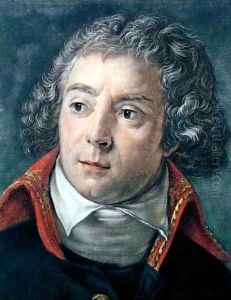Pierre Michel Alix Paintings
Pierre Michel Alix, born in 1762 in Paris, France, was a distinguished French engraver known for his portrait engravings which captured the likenesses of many prominent figures of his time. Alix's career flourished during a turbulent period in French history, spanning the final decades of the Ancien Régime, the French Revolution, and the Napoleonic era. Despite the political upheavals, he managed to navigate through these changing times, adapting his art to suit the prevailing winds of each regime.
Alix apprenticed under the renowned engraver Joseph de Longueil, which set the foundation for his mastery in the art of engraving. His talent for capturing both the physical likeness and the essence of his subjects quickly garnered him fame. He produced engravings of a variety of subjects, including French royalty, philosophers, scientists, and political leaders, thus documenting an important era in French history through his art.
During the French Revolution, Alix's works reflected the changing political landscape. He engraved portraits of revolutionary leaders and heroes, contributing to the cult of personality that surrounded figures such as Jean-Paul Marat and Maximilien Robespierre. Despite the potential dangers associated with political allegiances during this period, Alix managed to survive the Revolution's most tumultuous years, a testament to his skill and perhaps his ability to navigate the complex social and political networks of his time.
In the Napoleonic era, Alix continued to thrive, adapting his subjects to include members of the Napoleonic court and hierarchy. His engravings from this period serve as valuable historical documents, capturing the likenesses of those who were at the center of power during Napoleon's reign. Alix's work during the Napoleonic era exemplifies his versatility and his capacity to remain relevant despite the dramatic shifts in political power and artistic tastes.
Pierre Michel Alix passed away in 1817, leaving behind a legacy as one of France's most skilled and adaptive engravers. His body of work provides a fascinating visual record of the people and the changing political landscapes of late 18th and early 19th century France. Through his portraits, future generations are able to glimpse the characters who played pivotal roles in one of the most eventful periods of French history.
